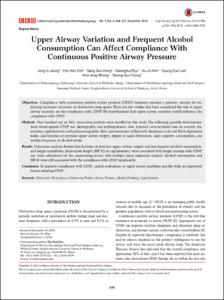KUMEL Repository
1. Journal Papers (연구논문)
1. School of Medicine (의과대학)
Dept. of Otorhinolaryngology (이비인후과학)
Upper Airway Variation and Frequent Alcohol Consumption Can Affect Compliance With Continuous Positive Airway Pressure.
- Affiliated Author(s)
- 정종인
- Alternative Author(s)
- Jeong, Jong In
- Journal Title
- Clinical and Experimental Otorhinolaryngology
- ISSN
- 1976-8710
- Issued Date
- 2016
- Keyword
- Obstructive Sleep Apnea; Continuous Positive Airway Pressure; Alcohol Drinking; Cephalometry
- Abstract
- Objectives : Compliance with continuous positive airway pressure (CPAP) treatment remains a primary concern for improving treatment outcomes of obstructive sleep apnea. There are few studies that have considered the role of upper airway anatomy on the compliance with CPAP. We hypothesized that upper airway anatomy would influence the compliance with CPAP.
Methods : One hundred out of 161 consecutive patients were enrolled in this study. The following possible determinants were tested against CPAP use: demographic and anthropometric data, minimal cross-sectional area on acoustic rhinometry, cephalometric and polysomnographic data, questionnaires of Epworth sleepiness scale and Beck depression index, and histories of previous upper airway surgery, degree of nasal obstruction, daily cigarette consumption, and weekly frequency of alcohol intake.
Results : Univariate analysis showed that histories of previous upper airway surgery and less frequent alcohol consumption, and longer mandibular plane-hyoid length (MP-H) on cephalometry were associated with longer average daily CPAP use. After adjustment for the confounding factors with multiple linear regression analysis, alcohol consumption and MP-H were still associated with the compliance with CPAP significantly.
Conclusion : To improve compliance with CPAP, careful evaluations of upper airway problems and life style are important before initiating CPAP.
- Department
- Dept. of Otorhinolaryngology (이비인후과학)
- Publisher
- School of Medicine
- Citation
- Jong In Jeong et al. (2016). Upper Airway Variation and Frequent Alcohol Consumption Can Affect Compliance With Continuous Positive Airway Pressure. Clinical and Experimental Otorhinolaryngology, 9(4), 346–351. doi: 10.21053/ceo.2015.01984
- Type
- Article
- ISSN
- 1976-8710
- Appears in Collections:
- 1. School of Medicine (의과대학) > Dept. of Otorhinolaryngology (이비인후과학)
- 파일 목록
-
-
Download
 oak-2017-0079.pdf
기타 데이터 / 582.57 kB / Adobe PDF
oak-2017-0079.pdf
기타 데이터 / 582.57 kB / Adobe PDF
-
Items in Repository are protected by copyright, with all rights reserved, unless otherwise indicated.